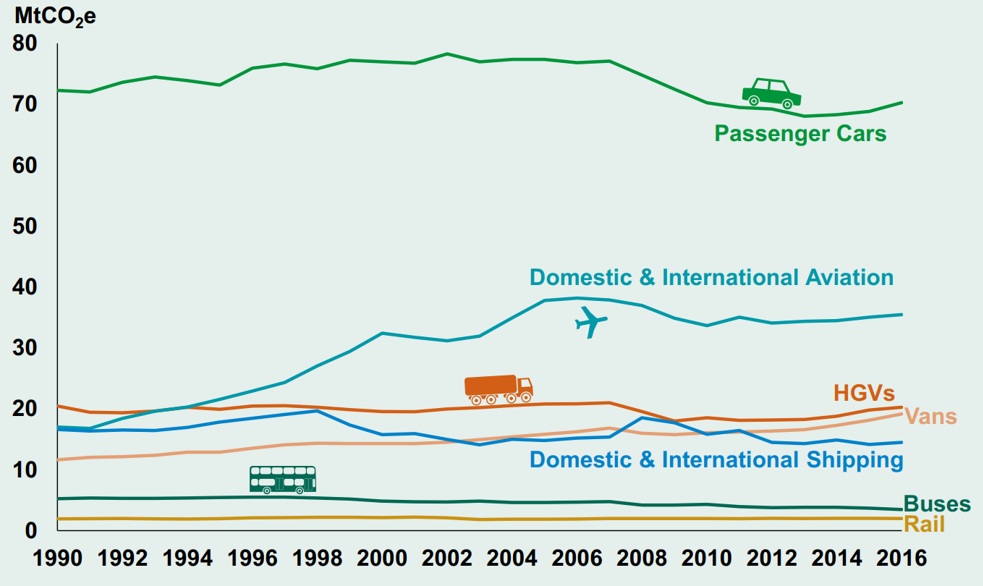
Derek Palmer, member of the CIHT Sustainable Transport Panel, outlines the implications that the 2018 IPCC “Special Report on Global Warming of 1.5°C” will have on transportation. Action is urgent and the transport sector has an important role to play if the challenges outlined in the report are to be overcome.
Join other savvy professionals just like you at CIHT. We are committed to fulfilling your professional development needs throughout your career
In October 2018 the IPCC (Inter-Governmental Panel on Climate Change) published its “Special Report on Global Warming of 1.5°C”. It argued that limiting global warming to 1.5°C (rather than 2°C as agreed as part of the Cancun agreement) is necessary but would require ”rapid, far-reaching and unprecedented changes in all aspects of society”. This will prove a significant challenge for the transport sector – even achieving a 2°C limit in the increase in global temperatures would have been difficult. One reason for the reduction from the original 2°C is that the IPCC believe that:
Global warming of 2°C is expected to pose greater risks to urban areas than global warming of 1.5°C. The extent of risk depends on human vulnerability and the effectiveness of adaptation for […] infrastructure sectors (energy, water, and transport).
It goes on to state that “rapid changes needed in urban environments include demotorisation and decarbonisation of transport, including the expansion of electric vehicles”. Technological and social innovations can, it concludes, contribute to limiting warming to 1.5°C.
Transport is vital in supporting the economic and social wellbeing of citizens across the world. At the same time, the sector faces a large challenge in terms of mitigating climate change to within 1.5°C degrees above pre-industrial levels, as the sector is one of the largest and fastest growing sources of greenhouse gases (GHGs).

Derek Palmer
TPP FCIHT FCILT
Derek is an economist, qualified transport planner and project manager with considerable experience of research, policy development and practice in relation to climate change.
Globally, transport currently accounts for 23% of carbon dioxide (CO2) emissions, having increased by 2.5% annually between 2010 and 2015. According to the IEA (International Energy Agency), OECD (Organisation for Economic Cooperation and Development) economies must reduce well to wheel (WTW) GHG emissions by more than 20% by 2025 (i.e. in 6 years’ time) in order to offset the continued emissions growth of more than 18% by non-OECD countries over the same period. The transport-related mitigation measures proposed in NDCs (Nationally Determined Contributions) are expected by the IEA to fall short of both medium- and long-term 2DS targets (even the 2 Degree Celsius Scenario let alone the lower target of 1.5°C).
If society is going to achieve an increase of only 1.5°C significant changes will need to be made in transport policy – deep decarbonisation.
Nationally Determined Contributions
NDCs are reductions in GHGs that all countries that signed the UNFCCC were asked to publish in the lead-up to the 2015 United Nations Climate Change Conference held in Paris, France, in December 2015
Road transport is responsible for 17.5% of overall GHGs in Europe but emissions from the sector increased by 23% between 1990 and 2009. In 2016 road transport in the UK generated 114.2 million tonnes of carbon dioxide equivalent of which almost 2/3 (62%) is generated by car and taxi use. Total transport emissions account for nearly one quarter (24%) of all domestic emissions in the UK while car and taxi use alone account for 15%. This excludes, of course, CO2 emissions generated by the manufacture and disposal of vehicles. Indeed the Independent newspaper reported that the majority of Britain’s GHG emissions now come from transport.
 Department for Transport statistics on transport emissions in Great Britain. Source.
Department for Transport statistics on transport emissions in Great Britain. Source.
Efforts to reduce GHG emissions from the UK transport sector need to continue; transport professionals have a key role to play. If society is going to achieve an increase of only 1.5°C significant changes will need to be made in transport policy – deep decarbonisation. The approach should encompass two strands: mitigation (taking measures to moderate and alleviate climate change) and adaptation (adjusting existing facilities to become more suitable).
Mitigation measures which have the potential to reduce CO2 emissions from the transport sector can be categorised as ASI – Avoid, Shift and Improve:
Supporting policy instruments designed to Avoid, Shift and Improve transport can be categorised into five distinct types of intervention, namely:
The integration of land use and transport planning could be particularly significant in GHG reduction. This requires the transport industry to work with planners to deliver public transport-oriented developments, “beads-on-a-string” developments, mixed use developments, higher density developments, and limits on parking. Promotion of non-car modes along with flexible working accommodation that can be integrated into new homes by the installation of high speed broadband and adaptive living space will also help. This seems obvious but still does not automatically get included in planning discussions for new development.
Regulation (and its enforcement) is a matter for central and local government, and the police. A range of measures can be adopted including e.g. pedestrian zones, traffic management measures, Low Emission Zones in city centres, speed restrictions etc.
Economic instruments are generally found in the form of subsidies for low emission vehicles, higher vehicle and fuel taxes and parking charges, and introducing road user charges. These instruments aim to:
Economic instruments can be clearly linked to the Avoid, Shift and Improve strategies to reduce GHGs from the transport sector, as described below:
Information instruments may not be as effective as some other interventions. Measures that can be taken by transport professionals include public awareness campaigns, car free days, eco-driver training, travel plans.
A range of technology instruments, favoured by the IPCC, are available for introduction. New buses should be constructed to Euro VI emission standards, maintaining the efficiency of the existing bus fleet, introducing electric vehicles are all appropriate measures.
The positive mitigation effects of these types of economic instruments are likely to be higher, if they are used in conjunction with each other interventions.
Transport professionals across all sectors of the industry have a very important role in delivering a reduction in GHG emissions. Working with professions in other sectors as well as elected politicians, transport professionals can challenge, suggest, recommend courses of action that need to be undertaken if the 1.5°C limit on global warming is to be delivered. It should not be left up to the campaign of school children, initiated by Greta Thunberg in Sweden, to lead the way in changing transport policy.
Derek Palmer.
Beads-on-a-string
Where development is concentrated around public transport nodes, The Demand for Public Transport, TRL, 2004, link.
Better Planning, Better Transport, Better Places
A CIHT working group, led by Sustainable Transport Panel chair Lynda Addison, is currently developing the “Better Planning, Better Transport, Better Places” advice which address how we build and manage our towns and cities in a sustainable way.
See presentation from Jon Parker here.
https://www.ipcc.ch/2018/10/08/summary-for-policymakers-of-ipcc-special-report-on-global-warming-of-1-5c-approved-by-governments/ or https://report.ipcc.ch/sr15/index.html
https://www.iea.org/etp/tracking2017/transport/
Runsen Zhang, Shinichiro Fujimori, and Tatsuya Hanaoka, The contribution of transport policies to the mitigation potential and cost of 2 °C and 1.5 °C goals, Environmental Research Letters, Volume 13, Number 5, April 2018
Dalkmann, H and Brannigan, C in GTZ (2007) Transport and Climate Change. Sourcebook Module for Policy Makers in Developing Cities. GTZ
{{item.AuthorName}} {{item.AuthorName}} says on {{item.DateFormattedString}}: